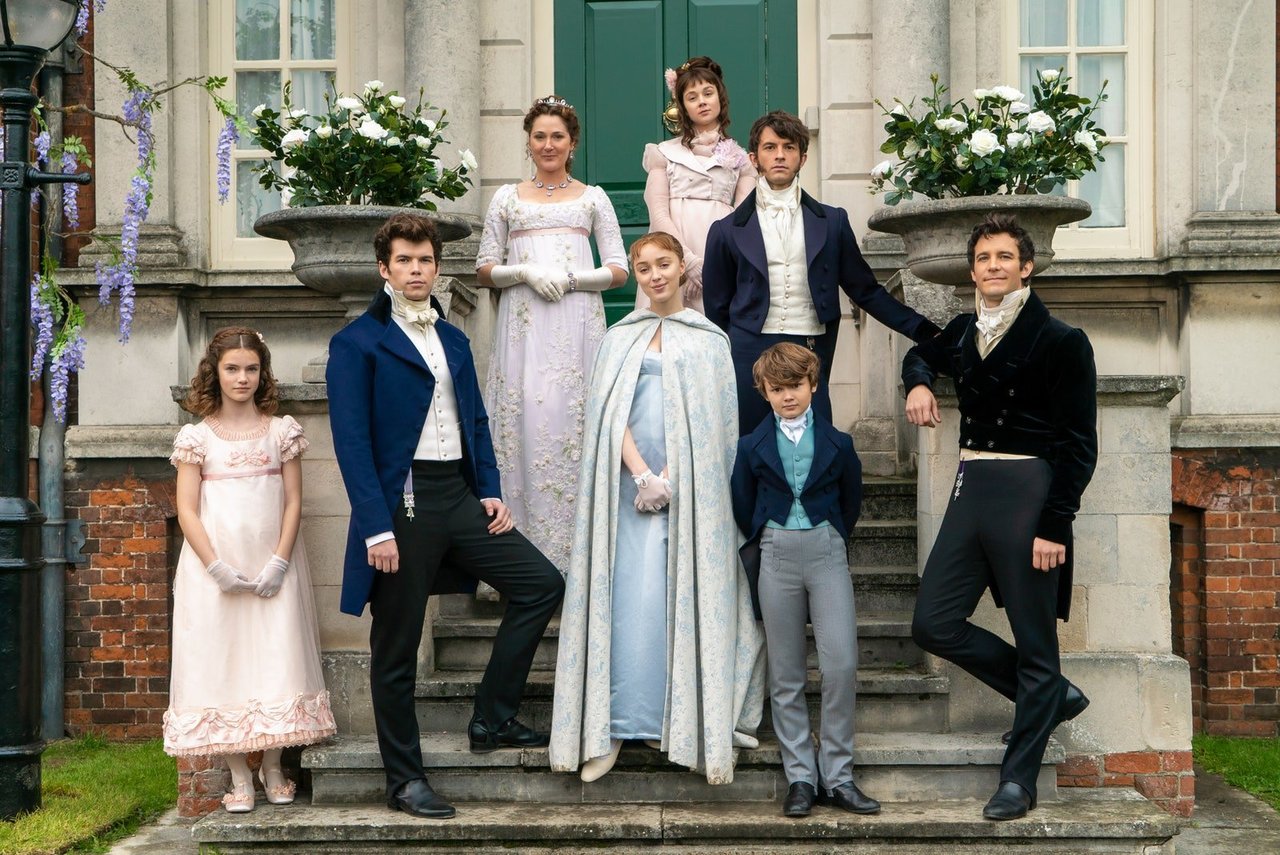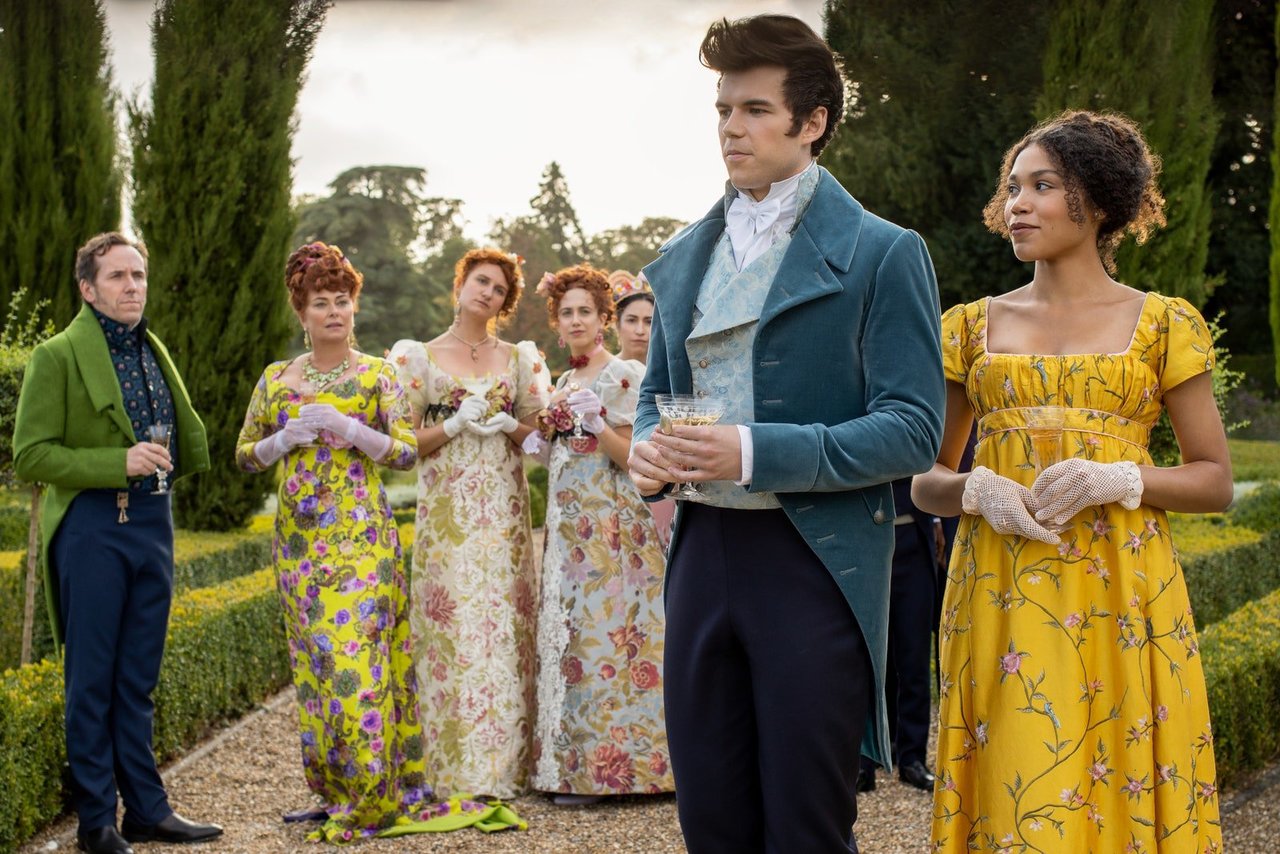Created by Chris Van Dusen, executive produced by TV legend Shonda Rhimes, and adapted from Julia Quinn’s bestselling Bridgerton novels, the eight-part series opens in 19th-century London. At its centre is Daphne (Phoebe Dynevor), the eldest daughter of the respected Bridgerton family, who’s set to be presented to the Queen (Golda Rosheuvel) and enter the marriage market. Joining her are the daughters of her hapless neighbor, Portia Featherington (Polly Walker), but when they fail to attract suitors and Daphne catches the eye of a duke (Regé-Jean Page), the claws come out.
For a show packed with bar-room brawls and secret assignations, bonnets and figure-swamping sacks would never do. Instead, every character is dripping in jewels, feathers and finery, hellbent on outshining one another. There are silk gowns rendered in ice-cream pastels, acid-bright florals, acres of ruffles, rhinestone-encrusted puff sleeves and wigs that could rival Marie Antoinette’s.
The person responsible for these flamboyant outfits is 71-year-old New York native Ellen Mirojnick, the prolific costume designer behind cult hits such as Fatal Attraction (1987), Wall Street (1987), and Basic Instinct (1992). In 2013, she took home an Emmy for her work on Steven Soderbergh’s glitzy Liberace biopic Behind the Candelabra and followed up with spectacular creations in The Greatest Showman (2017) and Maleficent: Mistress of Evil (2019). With Bridgerton, she outdoes herself again, transforming familiar Regency-era silhouettes into something fresh and fantastical.
Ahead of the show’s Netflix launch on December 25, Mirojnick talks us through her references and the details - from the curved necklines to the added layers of tulle - that demand a closer look.
Designing for Bridgerton must have been a huge undertaking. What was your starting point?
“At the very beginning, I thought I was just helping out. I’d known [Shonda Rhimes’s] Shondaland organization for a number of years and Sara Fischer, their head of production, called me. I went in to talk to Sara, [creator] Chris [Van Dusen] and [executive producer] Betsy [Beers] to see if it’d be possible to create something on this scale. I also knew the Shondaland aesthetic and understood that this was not going to be like a Jane Austen adaptation. How could we shift the aesthetics of a period drama to make it feel scandalous and modern? Then they asked if I wanted to do it and I jumped in because the challenge was too great. I’d never put together a costume house before.”
How many looks did this costume house ultimately create?
“It took five months to prepare before we went to shoot. The costume team came to 238 people. This is inclusive of the pattern cutters, the extraordinary Mr Pearl who was our corset maker, a tailoring department, an embellishing department, embroiderers and my co-captain John Glaser, among others. It was like a Bridgerton city of elves working continuously and they were brilliant. In the end, there were about 7,500 pieces - from hats to shawls, to overcoats - that made up the [estimated] 5,000 costumes that went before the camera. For Phoebe [Dynevor, who plays Daphne Bridgerton] alone, there were 104 costumes. That’s a big number, even for a principal player.”
Bridgerton’s author Julia Quinn has shared images of your moodboard for the show, which includes everything from paintings to runway looks. What were your main references?
“I looked at the Regency period in London through drawings and paintings. We got a flavor of it and then it was about looking at the different silhouettes and shapes while knowing that this had to be aspirational, as opposed to historically accurate. We knew that we had to shift the color palette and the fabrications, so from the 19th century, I immediately went to the 1950s and 1960s. The Christian Dior: Designer of Dreams exhibition at [London’s] Victoria & Albert Museum provided a wealth of inspiration. We looked at Dior dresses, from the New Look to the present day.”
If that classic empire silhouette was the foundation, how did you modify it to make the world of Bridgerton visually distinctive?
“We wanted to experiment with it by layering on other fabrics and embellishment. Using either organza, organdy or tulle, we could create another layer on top of the dresses that gives it a new sense of movement and fluidity. It’s almost like a trick of the eye that makes you see it differently.”
Is it true that bonnets were banned?
“There were no bonnets, but we do nod to them with our hair accessories. We took that half-moon shape and created these straw [pieces] accented with flowers or feathers that sit on top of the head. Another no-no were muslin dresses. There’s a limpness to them that we didn’t want.”
What other subtle techniques did you use to make these period costumes feel more modern?
“We paid a lot of attention to the scooped necklines and how they fit the bust, as opposed to having a [straight] line that doesn’t allow you to see the body. This show is sexy, fun and far more accessible than your average restrained period drama and it’s important for the openness of the necklines to reflect that. When you go into a close-up, there’s so much skin. It exudes beauty.”
As a family, the Bridgertons are incredibly refined. How did you perfect their aesthetic?
“They’re the prominent family of the social season so we wanted their color palette to be powdery - these pale blues, silvers, and greens that feel like whispers of color. Later on, as Daphne gets older, the colors become duskier. The pinks and blues are richer and the silvers deepen as she grows and matures. She begins as a porcelain doll and becomes a woman.”
In contrast, the Featheringtons love garish patterns. How much fun were they to design for?
“The Featheringtons are new money and [the mother] Portia [played by Polly Walker] needs to marry her daughters off. She sets the tone for them as a family and their color palette is overly citrus because she wants those girls to be seen. It might be too much, but that’s not on purpose. She thinks they look beautiful. Portia wears these prints and often you’re not sure if she’s more like Joan Collins or Elizabeth Taylor. They’re bolder, brighter and more brazen than everyone else, and everything is overly embellished. They just don’t know any better.”
Considering all these eccentric characters, who was your favorite to dress?
“I love Queen Charlotte [played by Golda Rosheuvel]. The real Queen Charlotte was known for never changing her silhouette from when she became queen in the 18th century. So, it was quite elaborate between her gowns, the trims and her hair, which changes all the time. She looks like cotton candy in every conceivable flavor. For me, she embodies what Bridgerton is all about.”













